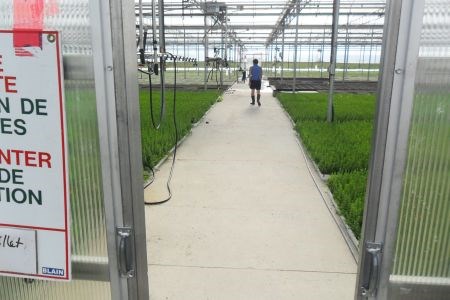La Maison Verte, a Hearst not-for-profit reforestation grower, spent the majority of December installing a $230,000 geothermal heating pump for one of its greenhouses, and plans on using January and February to test it.
Seeds were planted nearly three years ago when La Maison Verte submitted an application to the Northern Heritage Fund Corporation, under the watch of then-general manager Michelle Lamy, for funding for the project.
“It's the first in Hearst, in terms of a big geothermal project,” said general manager Manon Cyr.
The organization was recently approved for $121,325 through a provincial investment by the Northern Ontario Heritage Fund.
When the final costs are tabulated, Cyr said the project should come in at $230,000.
Multi-Energy, a local green tech company, and Geothermie Boreale, a Quebec heat pump manufacturer, worked together to build the geothermal system, which was constructed in the greenhouse that grows tomatoes.
Multi-Energy built and installed 88 metal posts to distribute the heat from the ground, while Geothermie Boreale focused on the thermal pumps, and the connection to the control system.
“Geothermal was interesting for us, because in that greenhouse, there is a lot of humidity, and a lot of tomatoes were wasted because of the mould,” said Cyr. “The geothermal system is the best choice in regards to eliminating that humidity.”
Cyr said whatever they're producing and wasting, whether it's within the greenhouse or what they haven't sold, is what they have to address.
“You can only make money with what you sell, not what you produce.”
La Maison Verte tested a small-scale geothermal system before moving forward with the project, and was pleased with the results.
“So we knew that if we wanted to use renewable energy for that greenhouse, the best one for that would be geothermal,” said Cyr.
Before construction on the project, Multi-Energy visited a greenhouse in small town near Trois-Rivières, Quebec, which had a very similar system.
They discussed the technical aspect of owning a geothermal heating system, along with the benefits and disadvantages.
“When I talked to the owner of the greenhouse, he was very satisfied with his system,” said Cyr. “He recommended us to go ahead with the system.”
The construction of the project needed to be built, installed, and operational by the end of December, giving Multi-Energy and Geothermie Boreale roughly one month to get everything running.
“January and February, we will be testing the system for any problems,” said Cyr. “Usually at the end of January we move into that greenhouse with our tomato plants, so that's quite a short timeframe, so we had to wait until production was done and then empty the greenhouse.”
The biggest cost has always been heating, and they're aiming for a 70 per cent reduction from their existing system with the geothermal pumps in place, said Cyr.
“We have to look long-term.” she said. “When your biggest cost is heating, you have to believe in your product and say, 'Okay, it will be hard for a few years but we have to believe that what we are doing is the right thing and the project will help us from there.'”
Cyr said that this may also open the doors in the future for similar projects.
“At least we can see moving forward if it's something we can apply elsewhere, or even allow us to consider having a longer season if our costs are done.
“There are so many opportunities.”




